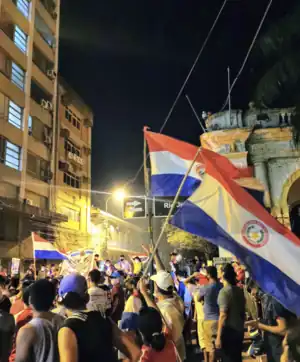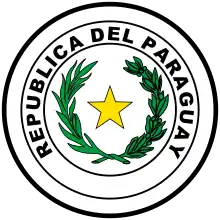2021 Paraguayan protests
The 2021 Paraguayan protests were a series of mass protests and violent demonstrations against the government's response to the COVID-19 pandemic in Paraguay during march 2021, calling for the resignation of Mario Abdo Benítez and his entire cabinet. The demonstrations left hundreds injured and many critically wounded after citizen protests and looting across the country. It resulted in the resignation of health minister Julio Mazzoleni.[2][3]
| 2021 Paraguayan protests ("#EstoyParaElMarzoParaguayo2021") | |
|---|---|
| Part of Protests over responses to the COVID-19 pandemic | |
 | |
| Date | March 5, 2021 – March 26, 2021 |
| Location | |
| Caused by |
|
| Goals |
|
| Methods | Demonstrations |
| Resulted in |
|
| Deaths and injuries | |
| Death(s) | 1 |
| Injuries | 20 [1] |
Background
Paraguay has a history of protests, with the 2017 Paraguayan crisis, the 2012 protests over the impeachment of Fernando Lugo, the 1999 Marzo paraguayo unrest and the 1986 protests. The political crisis is the worst since the 2017 protests. Gunshots were heard during the protests as protesters formed roadblocks and ignited barricades in the country. The government hasn't faced this kind of protests at all, refusing to resign and cracking down on protests harshly.[4]
Protests
The protests began on 5 March after protesters staged Cacerolazo in Asuncion, then turning out to protest the turmoil and calling for the political government to step down. Fires and smoke arose across Asuncion as city-wide protests turned into widespread violence and rioting.[5]
Protesters chanted slogans against the government and marched with pots despite rubber bullets, tear gas, live ammunition and water cannons fired at protesters by the attacking Riot police, being the most violent protests since the 2017 Paraguayan crisis.[6]
Hundreds threw stones and set fires across the country as well, but in smaller magnitude. Anger over the response led to calls for the government to resign amid violent riots and clashes with the security forces, loyal to Mario Abdo Benitez.[7]
As protests and popular demonstrations escalated the next day, police presence became heightened and small scuffles with protesters resulted in the rallies being quelled with hundreds injured. Protesters repeatedly marched in organised rallies peacefully in red-colourful shirts the next day, and participating in Cacerolazo across the capital and country.[8]
References
- "Coronavirus: Paraguay president dismisses ministers". BBC News. BBC. 7 March 2021.
- "Fire, smoke, gunshots in Paraguay capital as pandemic response ignites protests". Reuters. March 6, 2021.
- "Paraguay protests against pandemic response". TRT World. 6 March 2021.
- "Protesters injured after police clashes of Paraguay's Covid response". Independent.co.uk. The Independent. 6 March 2021. Archived from the original on 2021-03-06.
- "Fire, Smoke, Gunshots in Paraguay Capital as Pandemic Response Ignites Protests". USNews. 5 March 2021.
- "Protests erupt over Paraguay's handling of COVID-19". Al Jazeera. 6 March 2021.
- "Paraguay protests erupt over government handling of Covid-19". France24. 6 March 2021.
- "Protesters and Police Clash in Paraguay Amid Anger Over Pandemic Response". The New York Times. NewYorkTimes. March 6, 2021.
